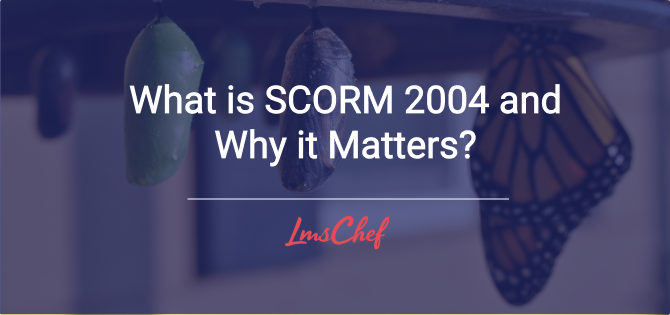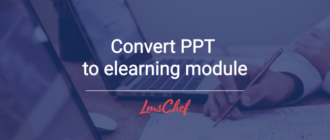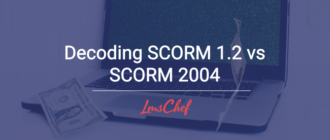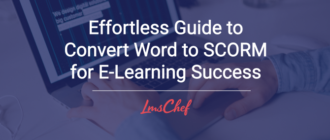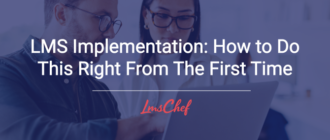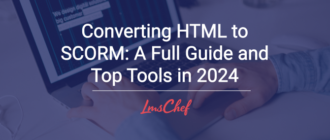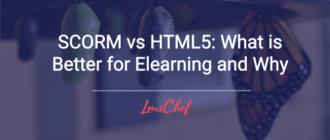Are you navigating the world of eLearning standards and wondering what is SCORM 2004? Simply put, it’s a set of technical standards that has transformed the way online learning content is developed and delivered. With its focus on interoperability and enhanced learner tracking, SCORM 2004 is crucial for anyone involved in designing or implementing eLearning solutions. This guide will illuminate SCORM 2004’s role and its significance in advancing online education.
Key Takeaways
- SCORM 2004 is the latest standard for eLearning that offers interoperability, reusability, and enhanced tracking capabilities, representing an evolution from earlier versions like SCORM 1.2, with major improvements in content sequencing and navigation.
- While SCORM 2004 offers extensive benefits like efficient course design, improved learner tracking, and cost savings through reusability, it faces adoption challenges due to its complexity, compatibility issues with older LMSs, and limitations in mobile learning support.
- SCORM 2004 finds diverse applications in sectors such as corporate training, higher education, and government and military training, facilitating better tracking, standardized content packaging, and compliance with training requirements.
Understanding SCORM 2004

SCORM 2004 is an international standard for eLearning courses that provides technical requirements for course development and interaction with learning management systems. It was developed to address eLearning interoperability, reusability, and durability challenges, ensuring scorm conformance and scorm conformant content throughout the process.
SCORM 2004 (4th Edition) represents the latest of the scorm versions, underlining the continual evolution and honing of the standard.
Evolution from SCORM 1.2
SCORM 1.2 was the first version of SCORM that gained wide adoption. However, it was limited in its ability to track course completion and success status, relying heavily on a single data model element known as ‘lesson_status’.
Unlike SCORM 1.2, SCORM 2004 brought about the concept of Sequencing and Navigation. This innovation enabled multi-SCO packages and regulated navigation among SCOs, paving the way for more detailed progress tracking and a flexible learning experience.
Key Components of SCORM 2004
The functionality of SCORM 2004 hinges on several integral components: the Run-Time Environment, SCORM Content Aggregation Model, and Sequencing and Navigation Specification. The Run-Time Environment defines how an LMS launches content and how content communicates back with the LMS using the ECMAScript (JavaScript) API. This includes a unique data model for each SCO, with elements and their values being governed through API methods.
The Content Aggregation Model deals with how to package and exchange content, while the Sequencing and Navigation Specification allows for detailed control of learning paths and navigation within courses. These features align with key ‘ilities’ such as accessibility, adaptability, affordability, and durability, providing long-term value by informing future content development through data reporting to cater more effectively to learner needs.
Benefits of Implementing SCORM 2004
The adoption of SCORM 2004 comes with a multitude of advantages, including:
- Emphasizes interoperability, facilitating the seamless integration of e-learning content with diverse Learning Management Systems
- Standardizes e-learning content format, increasing operational efficiency
- Reduces support burdens that organizations might face when dealing with multiple vendors
Moreover, organizations can benefit from cost savings through the reusability of instructional components across different courses and contexts, a feature enabled by SCORM 2004.
Enhanced Content Sequencing and Navigation

SCORM 2004 brought forth an innovative Sequencing and Navigation (SN) book, facilitating the incorporation of multiple SCOs into a single content package, such as a zip file, with superior sequencing capabilities compared to SCORM 1.2.
This new specification supports more advanced sequencing rules and workflows, creating more adaptive and personalized learning experiences. Content authors can define adaptive learning paths within e-learning courses by mixing and matching SCOs and writing rules that adapt to learner input and mastery. This paves the way for more structured and effective training programs, such as military training.
Improved Learner Tracking and Reporting
One of the most significant enhancements of SCORM 2004 over its predecessors is its improved learner tracking and reporting mechanisms. SCORM 2004 incorporates a sophisticated tracking model that captures a learner’s:
- Completion status
- Satisfaction status
- Progress measure
- Score for each learning activity
It also allows for the storage of multiple objective data sets without reaching the data limit, making it possible to suspend data limit concerns.
The standard supports tracking of shared data between SCOs within a course, improving the assessment of a learner’s overall progress and understanding. Moreover, SCORM 2004 offers enhanced performance assessment by tracking separate statuses for completion and success, providing a more refined picture of learner engagement.
Greater Flexibility in Course Design
Another significant benefit of SCORM 2004 is the flexibility it offers in course design. The standard permits the formation of reusable Sharable Content Objects (SCOs), empowering authors to consolidate entire courses into one SCORM package.
This flexibility is further enhanced by SCORM 2004’s modular content development, which enhances the reusability and adaptability of eLearning courses. The standard supports creating libraries of content that can be imported into any SCORM-compliant LMS, promoting reusability and consistency across various training programs.
Challenges and Limitations of SCORM 2004
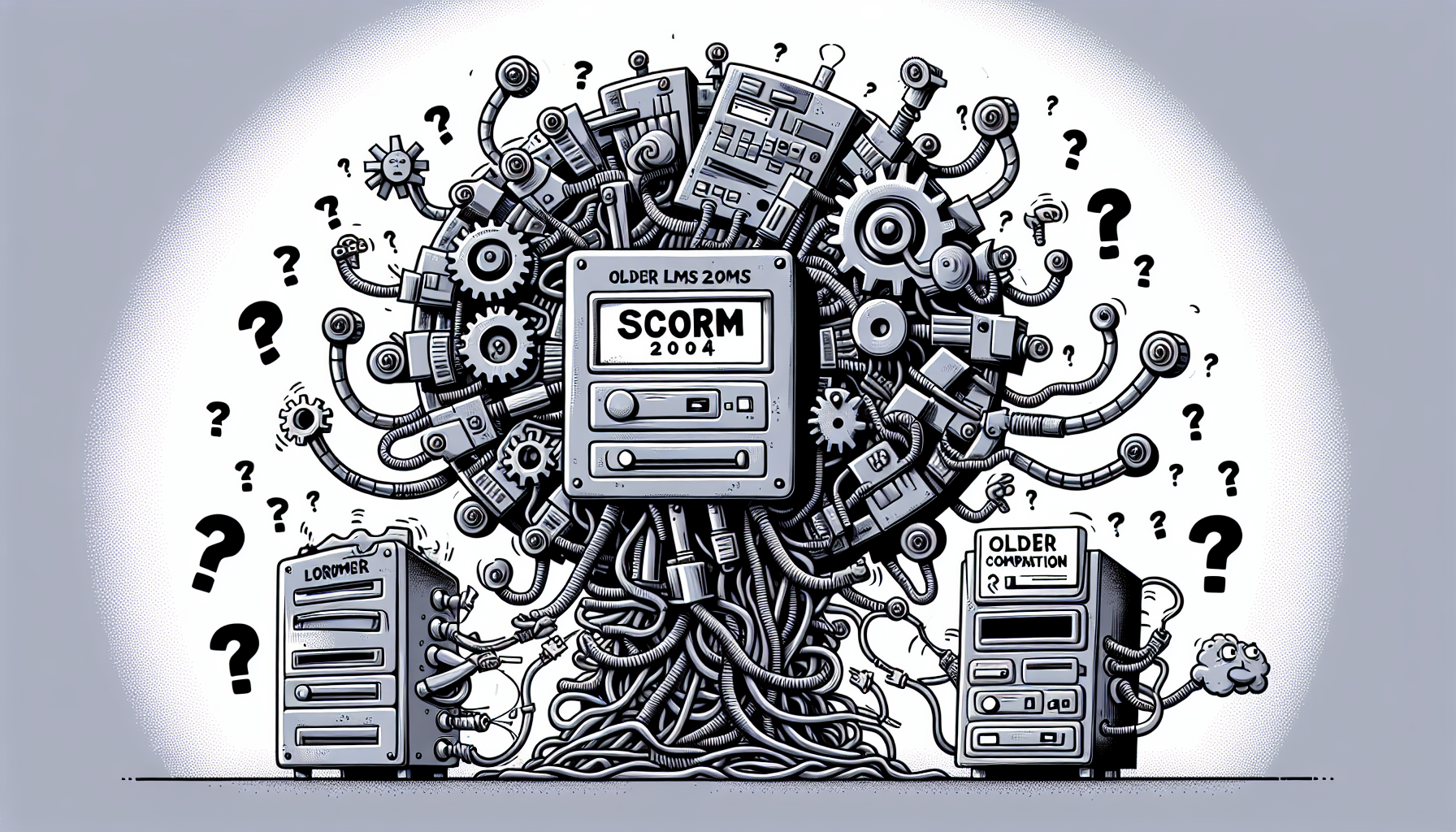
Despite the many advantages it offers, SCORM 2004 also presents certain challenges and limitations. The standard’s implementation can present technical challenges that complicate its integration into eLearning environments. Known technical issues include JavaScript vulnerabilities and complications arising from cross-domain API communication.
Complexity and Learning Curve
One of the main challenges of SCORM 2004 is its complexity, particularly in its Sequencing and Navigation book. This complexity has made its adoption challenging for many eLearning vendors. The steep learning curve and the absence of straightforward ‘getting started’ guides have also hindered SCORM 2004’s adoption. Content authors often require assistance from SCORM 2004 experts to implement the standard effectively, implying a need for knowledgeable support systems.
Compatibility with Older LMSs
Compatibility issues with older LMSs have also been a significant hindrance to the widespread adoption of SCORM 2004. LMS support for SCORM 2004 specifications is often inadequate, preventing the full execution of its technical capabilities.
Many eLearning professionals encounter difficulties in finding LMS platforms that fully embrace the SCORM 2004 specifications. Also, the architecture and feature set of SCORM 2004 significantly diverge from older standards like SCORM 1.2, prompting compatibility issues with LMSs built for earlier standards.
Limited Support for Mobile Learning
SCORM 2004 also has limited support for mobile learning, an increasingly important aspect of modern eLearning environments. The content is not inherently optimized for mobile devices due to fixed design specifications, and it relies on devices having modern web browsers with JavaScript support.
Another significant limitation is that the SCORM standard does not natively support offline learning, rendering mobile learning impractical when an internet connection is unavailable. Unreliable internet connections on mobile devices can also lead to a loss of completion data for SCORM 2004 content, disrupting the learning process.
Comparing SCORM 2004 with Other eLearning Standards
Having delved into the advantages and challenges of SCORM 2004, let’s now juxtapose it with other eLearning standards for a more comprehensive understanding of the eLearning milieu. These comparisons highlight the differences in adoption rates, tracking capabilities, and adaptability to future learning technologies.
SCORM 1.2 vs. SCORM 2004
When comparing SCORM 1.2 and SCORM 2004, it’s clear that SCORM 1.2 is more widely supported, with over 90% of LMS and authoring tool vendors supporting it, while SCORM 2004 has significantly less support.
Despite this, SCORM 2004 offers more comprehensive learner tracking and reporting mechanisms than SCORM 1.2. However, its implementation is more complex than SCORM 1.2, leading to a steeper learning curve and potential conflicts.
Both SCORM 1.2 and SCORM 2004 are limited to web content, with no expansion in content delivery capabilities in the later version.
SCORM 2004 vs. xAPI
When comparing SCORM 2004 with xAPI, a key difference emerges in the environments they support. While SCORM 2004 is integrated with many LMSs and designed for traditional eLearning, xAPI allows tracking of learning experiences across various environments, including mobile devices, simulations, and real-world activities.
Moreover, xAPI can capture detailed data on learner behavior, offering rich analytics for personalized learning experiences which SCORM 2004 does not provide. Although SCORM 2004 is widely established, xAPI is more adaptable to future learning technologies and methodologies.
SCORM 2004 vs. cmi5
A comparison between SCORM 2004, which utilizes the package interchange file format, and cmi5, another xAPI profile, indicates that cmi5 facilitates simpler integration with other systems, thereby expanding market opportunities for eLearning content.
cmi5 uses an xml file with XML metadata to describe a Course Structure, made up of container blocks and Assignable Units, which are imported into LMSs. This allows LMSs to communicate with xAPI-powered learning activities and specifies course launch mechanisms.
Practical Applications of SCORM 2004
SCORM 2004 extends beyond being merely a theoretical standard – it finds practical application across diverse sectors. From corporate training to higher education and government and military training, SCORM 2004’s standardization, interoperability, and tracking capabilities enhance the learning experience and outcomes.
Corporate Training
In a corporate setting, SCORM 2004 bolsters training processes by guaranteeing the longevity of e-learning content. This durability is critical in corporate settings as it supports consistent training outcomes despite shifts in technology.
By avoiding the costs associated with frequent e-learning content redesign, corporations can benefit financially from SCORM 2004’s durability. This makes SCORM 2004 a long-term training solution that aligns with the strategic financial planning of corporations.
Higher Education
Within the realm of higher education, SCORM 2004 ensures standardized content packaging, facilitating institutions in enhancing course design via consistency and reusability. This support aids the implementation of diverse pedagogical models, a critical aspect in academic settings. By utilizing SCORM conformant content, institutions can further ensure the seamless integration of learning materials.
With SCORM 2004, instructors can use a learning management system to:
- Better track learners’ progress and performance, helping to tailor the educational experiences to individual needs
- Achieve greater accuracy in reporting and assessment analytics
- Align with global eLearning standards, enhancing the educational content’s value and exchange
This results in improved educational outcomes and a more efficient learning experience.
Government and Military Training
Government and military training also significantly benefit from the application of SCORM 2004. The standard allows the standardization of course structure across various government and military training programs, ensuring that learning materials can be easily shared, reused, and repurposed within these organizations.
This standardization conforms to the strict regulations and training requirements necessary in military and government sectors. SCORM 2004 enhances the tracking and reporting of trainee progress, improving training efficiency. Various departments can access learning analytics to make data-driven decisions for future training.
This broad application is evident in the United States Department of Defense, which has mandated SCORM compliance for all its eLearning products.
Summary
In summary, SCORM 2004 plays a crucial role in the eLearning industry, providing a standard for course development and interaction with learning management systems. While it boasts several benefits such as interoperability, operational efficiency, and cost savings, it also presents certain challenges and limitations, including its complexity, compatibility issues with older LMSs, and limited support for mobile learning. Nevertheless, its practical applications in corporate training, higher education, and government and military training, highlight its importance and relevance in today’s digital age.
Frequently Asked Questions
What’s the difference between SCORM 1.2 and 2004?
The core reporting elements of SCORM 1.2 and 2004 are the same, but SCORM 2004 offers more in-depth options such as complex navigation and sequencing. When choosing an authoring tool and LMS, make sure they are SCORM-compliant.
What is the purpose of SCORM?
The purpose of SCORM is to provide a set of standards and technical specifications that allow e-learning course creators to develop and share courses across various platforms, making it the industry standard for eLearning interoperability.
What edition is SCORM 2004?
SCORM 2004 is the 4th edition, which was released in 2009. This edition offers additional disambiguation of the sequencing specification and introduces new features to simplify the creation of sequenced content.
What are objectives in SCORM 2004?
In SCORM 2004, objectives provide a way to track the status of individual learning objectives and share this status across activities. They are often used as variables to control sequencing actions.
Which edition of SCORM 2004 should I use?
You should use SCORM 2004 3rd Edition as it has the most significant adoption among vendors. It is the most widely used edition of SCORM 2004.

